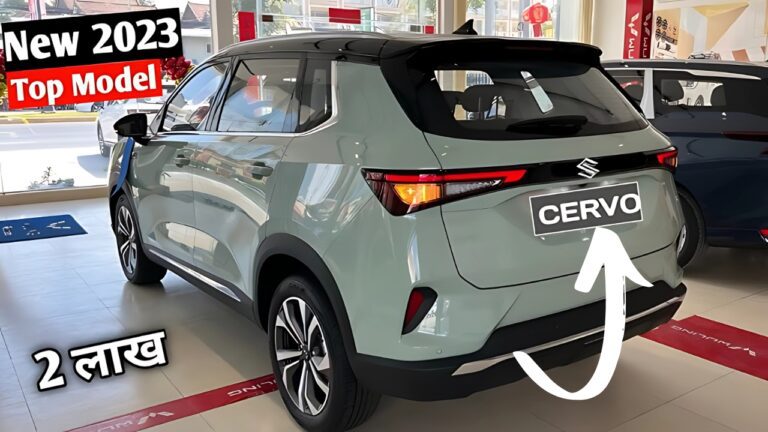
The Maruti Suzuki Cervo remains a fascinating “what might have been” in the story of India’s auto market. Introduced in Japan as a kei car, the Cervo promised compact dimensions, fuel efficiency, and smart urban mobility. But despite its potential, the car never made it to Indian shores. Here’s a look at the car’s history, what it could have offered to Indian consumers, and why Maruti Suzuki decided not to launch it.
A Brief History of the Suzuki Cervo
The Suzuki Cervo first hit Japanese roads in 1977, catering to the country’s unique kei car regulations. Designed to provide maximum functionality within strict limits on size and engine capacity, the Cervo became a symbol of innovation in urban mobility.
Across five generations, the Cervo evolved dramatically. From its coupe-like design in the 1970s to a modern hatchback by its final iteration in 2006-2009, every new model showcased innovative engineering. The last generation featured stylish design elements, advanced technology, and compact efficiency that made it a standout in Japan.
Technical Specifications of the Cervo
While the car never entered the Indian market, the 2006-2009 Japanese version offers a glimpse of what it could have brought here.
Key Specifications:
- Engine Options:
- 660cc naturally aspirated petrol (54 PS)
- Turbocharged petrol options (up to 64 PS for the SR version)
- Transmission:
- 4-speed automatic (standard models)
- 7-speed CVT (premium variants)
- Dimensions:
- Length: 3.4 meters
- Width: 1.48 meters
- Height: 1.53 meters
- Fuel Efficiency: Estimated 20-25 km/l (in Japanese conditions)
- Seating Capacity: 4 passengers
Notable Features:
- Keyless entry and ignition
- Automatic climate control
- ABS with EBD
- Dual airbags
- Premium interior materials and design enhancements
These specifications demonstrate that the Cervo wasn’t just a basic car—it blended style and performance while offering practicality for city driving.
Why the Cervo Never Launched in India
Despite the obvious potential, Maruti Suzuki decided against debuting the Cervo in India. Here are the reasons why the car didn’t make it to Indian roads.
1. Strong Internal Competition
Maruti already had a stronghold in the entry-level car market with models like the Alto, WagonR, and Celerio. The introduction of the Cervo risked cannibalizing sales of these existing cars.
2. Cost vs. Price Equation
Adapting the Cervo to Indian safety, emissions, and feature expectations would have required significant investment. Maintaining an affordable price while ensuring profitability was likely a challenging equation to solve.
3. Changing Consumer Preferences
By the mid-2010s, Indian consumers were leaning toward larger vehicles like compact SUVs. The ultra-compact dimensions of the Cervo might not have fit the aspirations of many buyers.
4. Market Position Complexity
Maruti Suzuki’s lineup was already diverse, and finding the right market position for the Cervo without causing confusion was another hurdle.
5. Regulatory Challenges
While designed for Japanese kei car standards, the car would have needed modifications to meet Indian regulations. This adaptation could have further increased development costs.
What Could the Cervo Have Meant for India?
Had Maruti introduced the Cervo, it might have created a new niche in India’s automotive market—a premium ultracompact car for urban buyers who prioritize fuel efficiency and maneuverability. Here’s how it could have influenced the market.
- Rise of Urban Cars: The Cervo’s compact dimensions would have made it an ideal fit for congested city roads.
- Alternative to Premium Hatchbacks: With its modern styling and features, the Cervo might have appealed to buyers who found the Alto too basic but didn’t want larger hatchbacks.
- Fuel Efficiency Leader: Its high mileage figures could have helped Maruti reaffirm its leadership in economical cars, especially during times of rising fuel prices.
- Push the Compact SUV Trend: Cars like the Renault Kwid and Maruti S-Presso already combine compact dimensions with SUV-like styling. The Cervo could have pioneered a different path.
Looking Ahead – The Spirit of Cervo Lives On
While the Cervo remained an untapped opportunity for the Indian market, it set the stage for innovations in compact car design. Today, Maruti Suzuki continues to evolve its portfolio to reflect changing consumer preferences. Models like the WagonR, Swift, and S-Presso embody the efficiency and practicality that the Cervo once represented.
Additionally, India’s shift toward electric mobility makes ultra-compact vehicles like the Cervo relevant again. The push for affordable electric cars could result in new models taking inspiration from the kei car philosophy.
Final Thoughts
The Maruti Suzuki Cervo remains an intriguing part of automotive history—a car that could have rewritten the rules of compact mobility in India. While it never graced Indian roads, its story reminds us of the dynamic and often unpredictable nature of the automobile market.
Would the Cervo have been a hit in India? Perhaps. But even in its absence, it continues to fuel conversation and inspire exciting possibilities for the future of urban mobility.
Stay tuned to techowiki.com for more insights into automotive trends and fascinating stories from India’s car market!